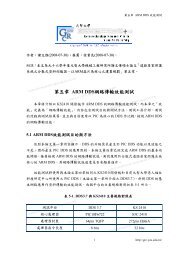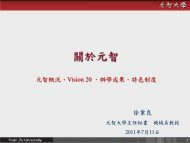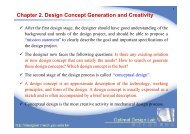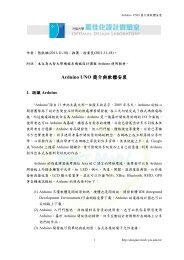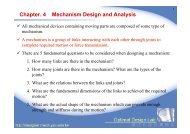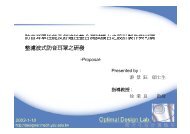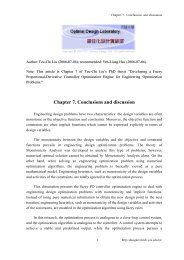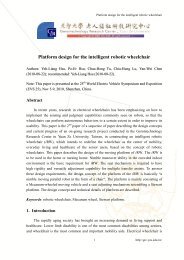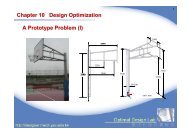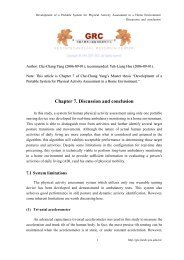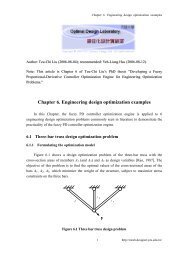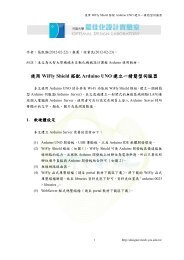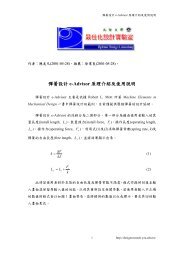PDF Version
PDF Version
PDF Version
You also want an ePaper? Increase the reach of your titles
YUMPU automatically turns print PDFs into web optimized ePapers that Google loves.
122 Yung-Chieh Hung and Yeh-Liang Hsugenerated between the magnetic hammer andelectromagnetic anvil can be changed by varyingthe distribution ratio of the magnetic flux by settingthe voltage from the electromagnetic anvil. A highvoltage increases the magnetic force of the electromagneticanvil, and vice versa.The original patent and new design concept B arealso substantially different in both ‘generation ofimpact torque’ and ‘change of magnetic flux’. First,the magnetic hammer rotates in sync with the motorbut the electromagnetic anvil is fixed. Second, thetorque generated between the electromagnetic anviland the magnetic hammer can be changed byvarying the distribution ratio of the magnetic fluxby setting the voltage from the electromagneticanvil. Third, the magnetic impact condition iscontrolled by the supply of electric current.As discussed above, results of innovation arepatentable and do not infringe upon the existingpatent. In these two new design concepts, thenumber of system components is reduced but alldesign requirements can still be met. Further productdevelopment can be carried out; issues in commercializationsuch as reducing the manufacturingcost of each component should also be considered.6 CONCLUSIONSystematic product design processes commonlyseen in research literature or design textbooks oftenstart from need-finding, specification development,conceptual design, detail design, to production.However, the design problems constantly faced byengineering designers in industries is how to designaround existing patents, which requires a completelydifferent design approach and knowledge.This paper proposes an integrated process fordesigning around existing patents through TRIZ.This process integrates patent design-around strategies,innovative design methods in TRIZ, and rules ofpatent infringement judgement. Facing innovationbarriers and possible patent disputes, the designproblem to be solved is first identified using thedesign-around strategies, as well as the functionmodel and value analysis in TRIZ. This ‘localinnovation’ design problem is then solved by TRIZmethodology, which not only avoids a trial and errordesign approach but also increases the degree ofinnovation. Finally, the feasible solutions generatedby TRIZ are analysed using the ‘triple identity test’(way/function/result testing) to make sure that thenew design concepts do not infringe on the originalpatent.In this design-around process, the rules of patentinfringement judgement present the major constraintsto local innovation design problems.Designers may have to sacrifice the performance ofthe product in order not to infringe on existingpatents, and the performance of the new designmay not exceed that of the original patent. However,this process provides a systematic way to generate anew design that is patentable and less likely toinfringe upon the existing patent. This integratedprocess should be especially helpful to technologyfollowers in developing their products speedily andwith a lower cost.ACKNOWLEDGEMENTThis project is partially supported by the Fuel CellResearch Centre, Yuan Ze University. This supportis gratefully acknowledged.REFERENCES1 Glazier, S. C. Patent strategies for business, 1990 (Lawand Business Institute).2 Miele, A. L. Patent strategy: the Manager’s guide toprofiting from patent portfolios, 2000 (John Wiley &Sons, Inc., New York).3 Nydegger, R. and Richards, J. W. Design-around techniques.In Electronic and software patents (Eds S. W.Lundberg et al.), 2000 (The Bureau of National Affairs,Inc., Washington, DC).4 Terninko, J., Zusman, A., and Zlotin, B. Systematicinnovation: an introduction to TRIZ, 1998 (St LuciePress, Boca Raton, Florida).5 Mann, D. Hands-on systematic innovation, 2002(CREAX Press, Belgium).6 Shinagawa, S., Nakayama, S., and Sekino, F. Magneticimpact tool. US Pat. 6,918,449, 2005.7 Invention Machine Corporation, http://www.inventionmachine.com/Proc. IMechE Vol. 221 Part B: J. Engineering Manufacture JEM667 Ó IMechE 2007



